Early Years in School: Physical Development - Move to learn
Anne O'Connor
Monday, January 23, 2017
Evidence of the vital mind/body connection in early development means we must take a less sedentary approach to learning, explains Anne O’Connor

There is significant evidence to suggest that children are leading increasingly sedentary lives both at home and at school, but the drive for more physical activity in the early years stems more from a medical direction than from education.
In his Ted Talk on creativity in education (2006), Sir Ken Robinson makes the comment, ‘What happens is, as children grow up, we start to educate them progressively from the waist up. And then we focus on their heads. And slightly to one side.’
This mind/body split seems to have a been a feature of education since Descartes famously announced, ‘I think, therefore I am’ (cited in Thom et al 2015), implying that the mind was all-important and the material body merely something to take control of and rise above. Through the educational ages, while our minds have been tutored, our physical bodies have been drilled through PT exercises and trained in PE and sports lessons, with opportunities to run about freely being confined to ‘playtime’ and lunch breaks.
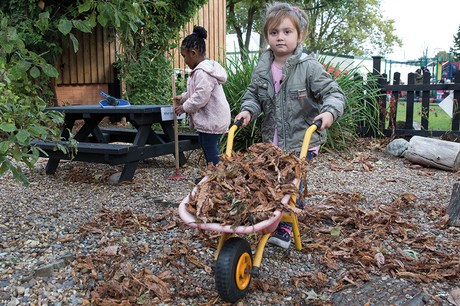
FREE PLAY IN NURSERIES
Traditionally, more attention was given to younger children’s bodily expression through free play in nurseries, and control of the body is now written into our EYFS Early Learning Goals. However, there is still a widespread notion, not least among Government ministers, that learning in Reception classes only takes place when children are sitting still and upright, uniformly dressed and listening to the teacher.
With increasing demands for formal activity in Reception (see, for example, the recent Teaching Schools Council report, http://bit.ly/2geMuWY), we are in danger of growing this mind/body split, rather than reducing it.
‘All learning begins with the body’
Anyone who spends time observing babies and young children will agree with the above statement by Connell and McCarthy in their book A Moving Child is a Learning Child. They add, ‘It has to. It’s our point of reference – our own personal, portable true north, so to speak. And for children, it’s even more so because the body is the brain’s first teacher. And the lesson plan is movement.’
Not only are movement and brain development closely linked, but the kinds of movement that seem to be most powerfully linked to neural growth in our earliest years are those that come naturally to children. It is as though they are biologically driven to wriggle and fidget, spin and slide, run and jump, specifically because they know it is good for them.
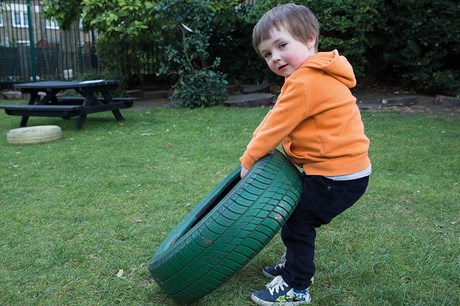
MOVEMENT AND ITS LINKS TO LEARNING AND DEVELOPMENT
Young children learn with their bodies. There is a process taking place whereby they ‘learn to move’ at the same time as they are ‘moving in order to learn’. Connell and McCarthy describe this process as a cycle that begins with the child moving – and ‘knowing’ more because they have moved. Then, the more the child knows, the more they want to know – and the more the child wants to know, the more they need to move. This would seem to be linked to the way the various parts of the brain work closely together.
For example, the cerebellum is the part of the brain where ‘muscle memory’ is stored, building up movement skills gradually and through repetition so that they become automatic, which is a big priority for the brain in a child’s earliest years. But it seems that the work that the cerebellum does in predicting, sequencing, rehearsing and timing movement is also linked with the way the same processes support cognitive development, helping us to predict, plan, order and carry out learning tasks: ‘The cerebellum can make predictive and corrective actions regardless of whether it’s dealing with a gross-motor task sequence or a mentally rehearsed task sequence’ (Jensen 2005).
Similarly, the vestibular system in the brain is linked not just to our ability to negotiate gravity and stay balanced, but also to our emotional health and urge to communicate.
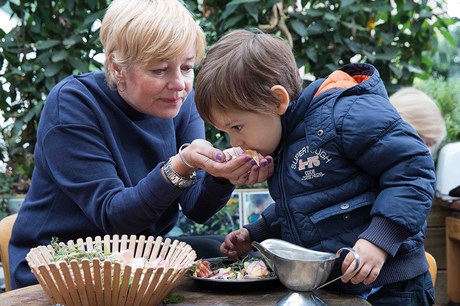
Sensory development
Sensory development is also immensely important to learning and is linked with our bodily experience through touch, taste, sight, sound and smell. Young children learning about the world around them through their senses are also building proprioception and learning all about themselves and their place in that world.
By engaging in ‘real work’ activities such as lifting and carrying, as well as interacting with their environment through movement play, they are developing internal maps that tell them where their bodies start and finish and how it feels to ‘be them’. Boisterous rough-and-tumble play is also an important feature of proprioceptive development as children interact with each other’s bodies to learn acceptable social and physical boundaries.
Automatic movement mastery
As proprioception develops, so the relationship between a child’s brain and their body grows stronger and automatic movement mastery increases. For example, a child no longer needs to look at their limbs to know what they are doing, building confidence and trust in their physical skills and leaving them free to concentrate on other things.
Spatial awareness
This sense of self in relation to the world is also very important in the development of spatial awareness. This has implications for many aspects of learning, including maths, language and geographical skills.
Understanding directionality is important not just for the ability to use symbolic and positional language such as ‘on’, ‘under’ and ‘behind’, but also for using number lines and exploring 2D and 3D shapes.
Spatial reasoning in maths and geometry, in particular, demands embodied experiences in early education, as outlined by Thom et al in their recent study of spatial reasoning in the early years (2015). In describing children’s use of gesture and embodied approaches to exploring geometry and number, they argue that ‘spatial reasoning compels renewed attention to the primacy of the experiencing body’ (cited in Spatial Reasoning in the Early Years: Principles, Assertions and Speculations).
Directional reasoning
Connell and McCarthy also emphasise the connections between children’s physical play and their ‘directional reasoning’, which helps them not just understand their own relationship with the world, but also the abstract concept of how things that are unrelated to them can relate to each other.
A lot of understanding about directionality comes with the growing development of the ‘midlines’ – invisible lines dividing the body from left to right, from top to bottom and from front to back, ‘providing a kind of organic geometry necessary to establish a three-dimensional understanding of space’ (Connell and McCarthy 2015).
Midline development is a naturally slow process that depends on movement and physical play as children learn to both isolate and co-ordinate different parts of the body in increasingly complex movement patterns.
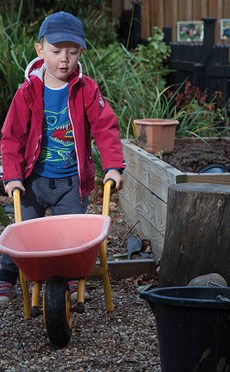
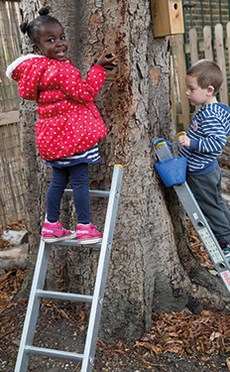 MOVEMENT AND HOW IT REINFORCES LEARNING
MOVEMENT AND HOW IT REINFORCES LEARNING
Most of us, as adults, find there are things we learn better when we can ‘do’ them for ourselves, rather than just reading from an instruction manual or memorising processes as we watch someone else carry out a task. Sometimes the ‘doing’ might even be unrelated to the learning task, as in those of us who need to doodle or twiddle with something during a lecture or training session.
Anchoring thought
Carla Hannaford, author of Smart Moves: Why Learning is Not All in Your Head (2005), reminds us that ‘movement anchors thought’, and many of us will know we can think better when involved in repetitive, physical activities that demand little concentration. ‘Movement helps young children to think, just as it does for adults, and yet we tend to assume fidgeting and fiddling with things to be evidence of poor concentration and a lack of attention’ (O’Connor and Daly 2016).
Physical play with objects, or through whole-body experiences, not only reinforces the neural pathways between the body and the brain but may also help to anchor children’s thoughts and learning processes.
Embodied teaching
There is no denying that working with young children is an extremely physical job, but it is worth remembering that our bodies are as much involved with our teaching as they are in all the practical aspects of our job. Telling stories, soothing anxious infants, demonstrating skills and techniques, encouraging and cheerleading, as well as physically joining in with young children’s play, all involve whole-body actions and responses and are part and parcel of the early years teacher’s day – never mind bringing in and out heavy equipment twice daily to create magnificent outdoor environments. But with an increasingly formal curriculum that has children spending greater amounts of time sitting working at directed tasks, our teaching role is also in danger of becoming more disembodied.
One of the great joys of working with young children is to share in their exuberant physicality and to allow ourselves the opportunities to dance and skip, to hug and tickle and to engage our whole bodies in activities that ‘grown-up’ life might not otherwise encourage (though that in itself is a sad indictment of our disembodied society).
Of course, we have a responsibility to fill our children’s lives with talk and language to stimulate and develop their communication skills, but we must also remember that ‘talking’ isn’t the only way we teach – and that we have just as much of an obligation to model embodied ways of living and learning.
Embodied learning embraces the need for the whole child to be free to be involved in their learning, whether it is through the opportunity to work lying on the floor rather than sitting at a desk, to jump up and down during an exciting story or to get dirty outside as they explore volume and capacity with mud pies.
Moving to learn, learningto move
It also acknowledges that as well as ‘moving to learn’, a young child is also still continually ‘learning to move’, and that being sedentary for several hours a day is not healthy for mind or body. Because of the way young children’s bodies are developing, being still actually tires them out more than physical activity and uses up valuable energy they need for engaging with, and learning from, the world around them.
Anne O’Connor is an author and principal consultant with Primed for Life Training Associates, providing training in physical development and the Prime Area of the EYFS.
IMPLICATIONS FOR PRACTICE
Given the importance of movement in developing, and reinforcing, children’s learning, consider the following questions:
- What opportunities do your children have to move freely throughout the day, indoors and outdoors?
- How do you make use of floor space as a place for children to pursue activities (to encourage crawling and time spent on tummies)?
- What routines and tasks can be moved away from tables/chairs?
- How do you encourage, monitor and assess children’s range of physical activity during the day?
- Does children’s play flow freely from indoors to outdoors and back again?
- How often do you engage in children’s physical play yourself?
- Is rough-and-tumble play something that children can engage in comfortably in your setting?
- Are you a good role model for embodied learning?
MORE INFORMATION
- Robinson K (2006), http://bit.ly/1glrr1H
- Thom J et al (2015) in Davis B (ed) Spatial Reasoning in the Early Years: Principles, Assertions and Speculations. Routledge
- http://tscouncil.org.uk/wp-content/uploads/2016/10/Effective-primary-teaching-practice-2016-report-web.pdf
- Jensen E (2005) Teaching with the Brain in Mind (2nd ed). Association for Supervision and Curriculum Development
- Connell G and McCarthy C (2014) A Moving Child is a Learning Child. Free Spirit Publishing
- Maude P (2001) Physical Children, Active Teaching: Investigating Physical Literacy. OUP
- O’Connor A and Daly A (2015) Understanding Physical Development in the Early Years: Linking bodies and minds. Routledge
- Bresler L (ed) (2004) Knowing Bodies, Moving Minds: Towards Embodied Teaching and Learning. Kluwer Academic Publishers
- White J (2015) Every Child a Mover. Early Education
- Archer C and Siraj I (2015) Encouraging Physical Development Through Movement-Play. Sage
- The Power of Physical Play, www.sirenfilms.co.uk
OUTDOORS AND ACTIVE
• Edith Kerrison Nursery School and Children’s Centre, where the photographs were taken, was one of a group of Newham settings involved in the east London borough’s Outdoors and Active research programme. The four-part series about the project, written by Julie Mountain, can be viewed at www.nurseryworld.co.uk




